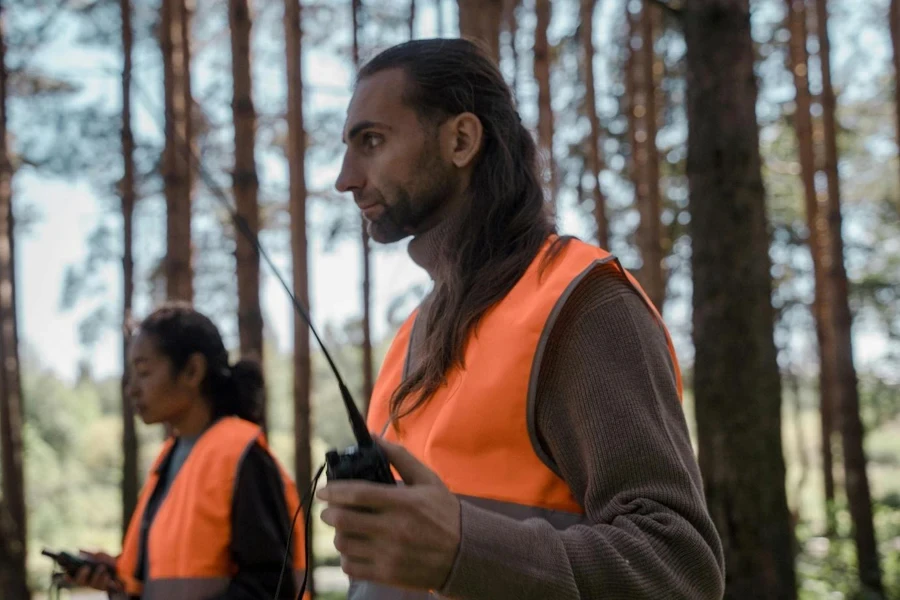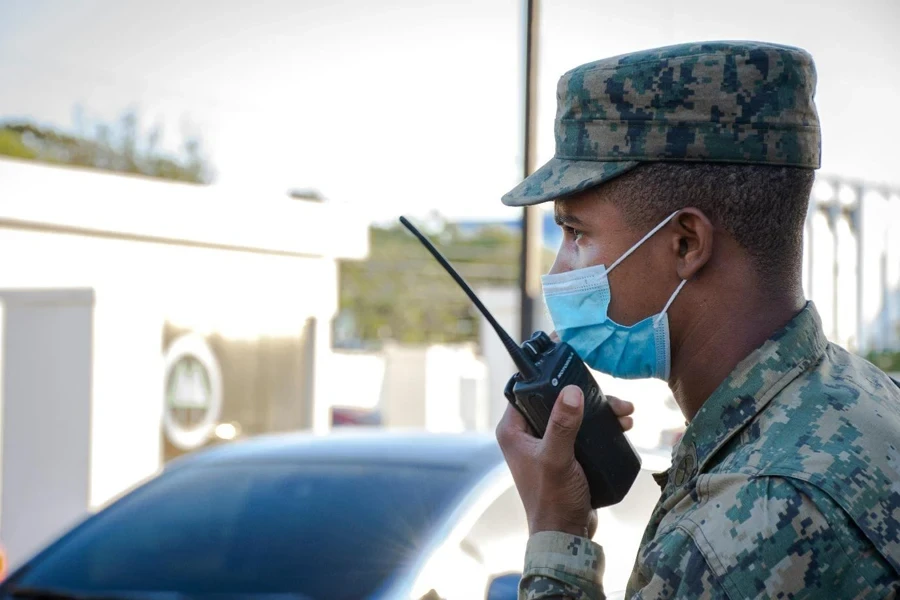In a time when effective communication is essential and highly valued, walkie-talkies are coming back in sectors like public safety and outdoor activities. The noticeable market expansion is fueled by technological advancements and a growing need for secure communication options, highlighting their significance. As professionals strive to keep up with emerging field trends, grasping the developments and top-performing models is crucial. This article presents insights into the changing landscape of walkie-talkies aiding businesses in making informed purchasing choices. Keeping informed about these advancements is essential to staying ahead in an evolving communication environment.
Table of Contents
● Understanding the walkie talkie market
● Innovations redefining walkie talkie technology and design
● Top walkie talkie models shaping market trends
● Conclusion
Understanding the walkie talkie market

Market scale and growth dynamics
The global market for walkie-talkies reached a value exceeding USD 3.5 billion in 2023 and is expected to witness expansion to reach USD 8.3 billion by 2032, fueled by the rising need for portable communication solutions, representing a yearly growth rate of 9 percent from 2024 to 2032. Across industrial and commercial sectors, the trend towards smaller and user-friendly devices is boosting adoption due to the critical importance of efficiency and real-time communication.
CAGR and market segments
According to a Global Market Insights report, the walkie-talkie industry is mainly split between digital and analog categories. In 2023, digital walkie-talkies dominated the market with more than 60% share. The superior performance, enhanced security features, and better audio clarity offered by digital models make them increasingly popular across various industries. Additionally, the commercial and industrial sectors are leading the market with a projected CAGR of over 9.5%, as companies are looking for communication tools to improve efficiency and safety protocols.
Regional insights
The walkie-talkie market in the Asia Pacific region is expected to experience growth with an estimated CAGR of over 10 percent from 2024 to 2032, as per the Global Market Insights report. This region’s rapid economic growth and expanding industries such as construction, manufacturing, and hospitality have significantly boosted demand. Additionally, the growing popularity of outdoor recreational activities like hiking and camping further drives the adoption of walkie-talkies, particularly in countries like China, Japan, and India. This regional growth highlights the increasing reliance on walkie-talkies as a vital communication tool in diverse environments.
Innovations redefining walkie talkie technology and design

AI and advanced connectivity
Walkie-talkies are getting a tech upgrade with AI-driven functionalities that improve voice detection and noise reduction capabilities. These developments use AI algorithms to distinguish between background noise and human conversations and communicate in settings like construction sites or crowded events. By incorporating LTE/4G connectivity options, wireless devices can connect to cellular networks and surpass typical radio frequencies with features like push-to-talk over cellular (PoC). This combination of connectivity guarantees that individuals can stay in touch in locations where traditional radio signals may not work consistently well by blending the advantages of radio with the wide reach of contemporary mobile networks.
Battery efficiency and form factors
The latest walkie-talkies feature high-capacity lithium-ion batteries that extend operational life and support quick-charge capabilities, charging devices up to 50% in less than 30 minutes. These batteries are built with energy systems that adjust power consumption according to usage habits, resulting in frequent recharges during long missions. In the design aspect, makers emphasize using polycarbonate and aluminum alloys to ensure toughness and lightweight properties. Some devices can be as light as 6 or 7 ounces. They are easily portable and durable enough for use without damage concerns. These gadgets are getting smaller, with built-in clip systems and customizable layouts that make it simple to connect them to other equipment. This ensures that the tools are strong and designed for long-term comfort when used in conditions.
Security and ruggedness enhancements

Security in walkie-talkies has advanced with the implementation of AES-256 encryption, a military-grade encryption standard that ensures communications are protected from interception. This is particularly critical in industries such as defense and emergency services, where the confidentiality of communications can be a matter of life and death. Furthermore, the new feature of dual-mode operation enables devices to transition between regular communication modes, offering flexibility based on the security requirements of each situation. In terms of ruggedness, walkie-talkies are now built to meet MIL-STD-810G standards, which means they can withstand extreme conditions such as temperatures ranging from -30°C to 60°C, high humidity, and repeated drops from heights of up to 2 meters. Devices are also equipped with IP67-rated housings, making them waterproof up to 1 meter for 30 minutes and resistant to dust ingress, ensuring reliable operation in even the harshest environments.
Top walkie talkie models shaping market trends

Outdoor and adventure-focused models
Walkie-talkies specifically for adventure activities are built to function well in challenging and ever-changing settings. Beloved by hikers, mountaineers, campers, and rescue teams, these types usually come with long-lasting battery life, sometimes up to a week from one charge, thanks to their powerful lithium-ion batteries. They boast ranges surpassing 25 miles under ideal circumstances, ensuring dependable communication in secluded or mountainous regions where cellphone reception can be spotty. Strong IP certifications such as IP67 (resistant to water and dust) are commonly found in some models that also feature polycarbonate casings and shock-resistant structures to endure falls and harsh conditions like extreme temperatures and moisture exposure effectively. Included functionalities like integrated GPS systems, barometric pressure sensors, and emergency alert features serve as layers of safety precautions for enthusiasts, enabling them to access location information or seek assistance in times of need. These devices cater to the needs of adventurers who value both durability and performance when exploring locations.
Budget-friendly options for casual users
These are the go-to choices for recreational individuals or families looking for an affordable option that prioritizes ease of use. These gadgets are good for recreational purposes such as camping trips, visits to theme parks, and events like festivals. These user-friendly models are favored by those who value communication during leisure activities due to their design and the convenience of using common AAA batteries that can be easily replaced as needed. Their compact size makes them convenient to carry and suitable for individuals of all ages who want to stay connected during various adventures. Despite being more affordable, in cost terms than higher-end options available today, entry-level models frequently cover 15–20 miles across landscapes and come equipped with fundamental yet vital functionalities such as access to NOAA weather channels for instantaneous weather updates. Designed with user-friendly controls and uncomplicated operations in mind, these models cater to individuals seeking user-friendly devices, making them particularly suitable for short-distance communication needs and sporadic usage scenarios.
Professional-grade models for industrial use
Walkie-talkies designed for use in commercial settings like construction sites and security teams are built to be tough and reliable for use over time. These devices usually have high transmission power (reaching up to 5 watts or higher), enabling them to communicate over long distances, even in places with obstacles. Crafted to endure tough conditions and rough treatment on the job site or in environments like event management settings, these walkie-talkies often come equipped with sturdy exteriors and protective features such as IP ratings like IP67 or higher that shield them from water damage, dust exposure, and impacts, from accidental drops or bumps. High-quality models are designed to function on GMRS or commercial UHF/VHF frequencies for use in job locations. They are also equipped with as many as 121 privacy codes to ensure communication and prevent interference on active channels. The industrial versions might also offer hands-free operation (VOX) and feature durable battery packs that enable prolonged usage during extended work hours. They cater to the demands of experts who need dependable communication to coordinate activities on intricate work sites.
Marine and water-specific models
Special walkie-talkies designed for marine activities are tailored to meet the needs of water sports lovers, fishermen, and boaters who work in aquatic environments and surroundings like lakes or seas. These walkie-talkie models are completely waterproof and have the ability to float if accidentally dropped into the water. They are specifically crafted to endure exposure to saltwater and possible submergence. These gadgets typically adhere to IP67 standards that ensure protection against water damage up to a depth of 1 meter for half an hour. Marine radios also come with NOAA weather channels that provide alerts for changing conditions – a key feature for those who require up-to-the-minute information about weather and water conditions. Certain models also have emergency functions like one-touch SOS signals that can send distress signals across all channels in an emergency. Designed to be lightweight yet robust and equipped with flotation capabilities, marine walkie-talkies cater to the requirements of users who spend time in water and value safety and durability.
High-power models for amateur radio (ham) enthusiasts
High-power walkie-talkies are favored by licensed ham radio operators who require versatile devices with expansive range and frequency flexibility. These models enable long-distance communication over varied terrains with transmission power often exceeding 5 watts and reaching up to 8 watts or more. Dual-band capabilities (VHF/UHF) are standard, allowing users to operate on amateur radio frequencies and tune into local and repeater channels, expanding communication options considerably. Equipped with programmable memory channels and customizable settings, high-power models are particularly suited for technical users who want precise control over frequency management. Security features like CTCSS/DCS encryption codes enhance communication privacy, and the devices’ high-capacity batteries support extended use in remote field operations. Although these models require a ham radio license for legal operation, their advanced features make them ideal for hobbyists and professionals who demand extensive control and communication range.
Conclusion

The walkie-talkie market is experiencing significant growth, driven by technological advancements that enhance functionality, connectivity, and durability. Innovations such as AI-powered features, extended battery life, and rugged designs are meeting the evolving demands of various industries. As these devices continue integrating with modern communication networks and offering specialized capabilities, their role in critical operations across sectors is becoming increasingly vital. The ongoing development of walkie-talkies is set to shape the future of portable communication, making them indispensable tools for professionals in diverse environments.




